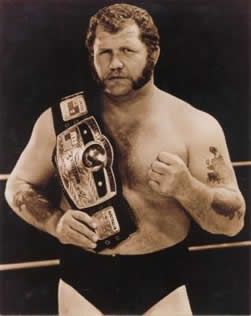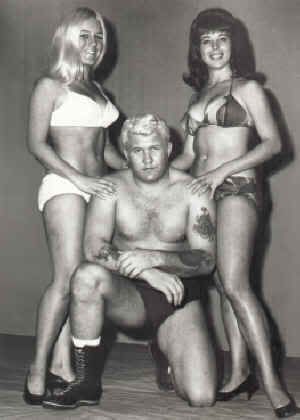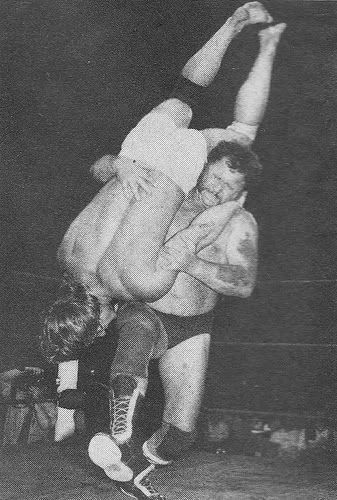wrestling / Columns
Going Broadway 05.15.12 The Once and Future King of the Ring

Gust Karras’ voice bellowed down the hospital hallway as he barged in the room.
“Over my dead body!” he exclaimed over the planned operation on friend and wrestler, Jack Long. The operation called for the amputation of one of Long’s legs after a devastating car accident that not only put Long’s leg in peril but also tragically claimed the life of his wife Vivian and their unborn child.
Karras’ adamant opposition was successful in blocking the amputation and saved Long’s leg. But the victory in saving the leg would be clouded by several months of rehab with the grim prospect that Long might not ever walk again, let alone compete as a wrestler.
During his recovery, Long’s father was supportive of him returning to the ring but gave him one crucial piece of advice. He told his son if he was to return to wrestling, he should only wrestle under his birth name and not work so hard to make the fictional handle he carried famous. Long took his father’s advice, and when he returned to wrestling in 1964, he would be billed under the same name he would use for the rest of his career in and out of wrestling.
He returned as Harley Race.
As a child, Race was presented with many obstacles in his path, least of which was overcoming polio at an early age. But the one thing he could fall back on for joy in his life was the professional wrestling shows he would watch from Chicago over the pioneering DuMont Television Network.
Eager to learn the trade at an early age, Race was tutored by the Zbyskos, Stanislaus and Wladek, two former World Champions. Perhaps it was the perfect storm of Race’s attachment to the sport and an incident at the school that started the path of one of wrestling’s most famous and respected workers.
While in the midst of a scuffle with another student, Race was suddenly caught in the bad of the head by a driving knee from of all people, the principal. Race, as we would all love to do if we were in the position, turned his singles bout into a handicap and took on the authority figure physically as well, which in the end proved to be his undoing as was later expelled for the attack.
But undaunted, Race took the expulsion as a sign that wrestling was his calling in life, and based upon an already impressive frame of well over 200 pounds of muscle, he found work with the St. Joseph wrestling territory in northeastern Missouri. Under the guidance of Gust Karras, Race not only got his opportunity to wrestle consistently, but he also learned the in’s and out’s of the wrestling business. By the time, he was 18, though, he pulled up stakes and moved east to Nashville, where he would form a tag team with John Long under the ring name of Jack Long.
The resulting car accident that claimed the lives of his wife and unborn child along with nearly taking his own leg in the process became a reset point in Race’s life. By the time he returned to the ring in 1964, he was wrestling under his own name and with an attitude that as quickly as talents could come they could be easily lost in the blink of an eye.
While wrestling down in Amarillo, Race would form a very fruitful tag team with Larry Hennig, which would provide the first glimpse of success in Race’s career. As a dominant and polarizing heel team, “Handsome” Harley Race and “Pretty Boy” Larry Hennig proved to be an instant draw and found steady work for the AWA by 1965. Their success culminated with the AWA Tag Team Titles on multiple occasions while fending off the likes of The Crusher and Dick The Bruiser. 
By the early 70’s, Race was traveling throughout multiple territories coast to coast. Under the banner of the NWA, his rising star status gradually grew from being strictly regional to being national to the point of being a contender for the NWA World Heavyweight Title. He wasn’t a contender for long, as he bested Dory Funk Jr. to win the belt in 1973, a short lived reign, but a significant milestone nevertheless.
After losing the World Title, Race was back on the road heavy, hitting territory after territory and amassing an impressive collection of championships, one of the most significant being the first ever United States Championship while competing in the Mid-Atlantic territory.
As the official number one contender to the World TItle, Race challenged, this time, Terry Funk for the “ten pounds of gold” in 1977 and once again found himself the top man in the business after forcing Funk to submit. Where his first title reign was a short lived quarter of a year, his second reign saw Race put the NWA on his back and make a go it up to six times a week as champion, facing challenge after challenge from the likes of contenders such as Dusty Rhodes. Nearly a four year continuous reign as champion, interrupted briefly by title losses that were quickly avenged.
Many weeks ago, we looked at Bob Backlund’s World TItle Tour with the WWWF title during this time, and Race was one of his adversaries. Race would work a similar circuit of fellow World Champions from different organizations such as Nick Bockwinkle and Billy Graham, a tactic used to draw massive cross appeal across different promotions.
Although he finally had his dominating run end at the hands of Dusty Rhodes in 1981, Race remained around the title picture and was primed for another crack at the belt when he faced Ric Flair in 1983. Practically the hometown favorite, Race upended Flair and captured the NWA World Title for an astounding and record breaking seventh time.
But Flair was quickly becoming the flower of the NWA’s eye by the 80’s and was primed to become the new face of the territory during a time when Vince McMahon was beginning to make waves with the WWF and its national expansion.
The Race-Flair feud became as big feud as any during the decade with Race taking on the heavy heel role; the aged veteran unwilling to be unseated by the young upstart. The charisma of Flair was matched perfectly with the grizzled tough guy Race. Their feud escalated to a bounty Race placed on Flair that was taken up by Dick Slater and Bob Orton, who attacked Flair and nearly put him out of wrestling with a neck injury. Flair’s impending retirement due to the injury was a short lived ploy that set up their epic and unforgettable battle at Starrcade: A Flair For The Gold, which Flair ultimately won, solidifying himself as not only the new NWA World Champion but also the new face of the organization.
Although there would be a short lived eighth reign for Race as champion after a victory over Flair in New Zealand (which to some is considered unrecognized), Race faded from the NWA scene as an in-ring competitor, turning his attention to promoting back in St. Louis and Kansas City where he had shares of ownership.
But by this point, Hulkamania was becoming a world wide phenomenon that became the crown jewel of McMahon’s wrestling empire, and combined with the many talent acquisitions made by the WWF from various regional territories, business in both St. Louis and Kansas City was beginning to suffer badly. So badly, in fact, to the tune of a nearly half a million dollar loss by Race himself in investments.
There was only one course of action… Join McMahon’s opposing force.
Race emerged on the WWF stage in 1986, but again, because Hogan was so popular, Race was not in any position to become their World Champion, but he was compensated by becoming the first ever King of the Ring, which led to his image as “King” Harley Race. He would remain in the WWF for three years before leaving in 1989. He did get to compete at Wrestlemania III when he defeated Junkyard Dog and he did get to feud with Hogan briefly, but by 1989, Race had left the WWF.
By 1991, Race had retired from the ring, but he remained a key fixture as an on-air character as he managed WCW’s top heels such as Lex Luger and Big Van Vader to World Title reigns. In terrible irony, a car accident in 1995 did what the accident in 1961 could not: it retired Race from wrestling all together. The resulting injuries and later hip replacement made it unbearable for him to even stand ringside as a manager.
But again, Race would regroup, and in 1999 he created the promotion World League Wrestling out of Eldon, Missouri and followed that by creating The Harley Race Wrestling Academy, which is still in existence today as training ground for future professional wrestlers.
What sums up the career of Harley Race so perfectly is the banner running across the top of his webpage: The Best Wrestler on God’s Green Earth. And no offense to Steve Austin, but probably the toughest son of a bitch to ever lace up the boots.
More Trending Stories
- Liv Morgan, Natalya & More React To Rhea Ripley’s Injury & Vacating WWE Women’s Title
- Goldberg Won’t Comment On Vince McMahon Allegations: ‘It’s Not My Place’
- Will Ospreay Says He Will Retire Using the Storm Driver After AEW Dynasty
- Drew McIntyre Confirms Injury, Reveals Why He Didn’t Just Leave at WrestleMania 40







